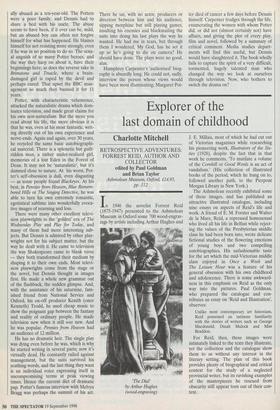Explorer of the last domain of childhood
Charlotte Mitchell
RETROSPECTIVE ADVENTURES: FORREST REID, AUTHOR AND COLLECTOR edited by Paul Goldman and Brian Taylor Ashmolean Museum, Oxford, £14.95, pp. 112 In 1946 the novelist Forrest Reid (1875-1947) presented to the Ashmolean Museum in Oxford some 700 wood-engrav- ings by artists including Arthur Hughes and The Dial' by Arthur Hughes (wood-engraving) J. E. Millais, most of which he had cut out of Victorian magazines while researching his pioneering work, Illustrators of the Six- ties (1928), despite the fact that in that work he comments, 'To mutilate a volume of the Comhill or Good Words is an act of vandalism.' (His collection of illustrated books of the period, which he hung on to, followed another path, to the Pierpont Morgan Library in New York.) The Ashmolean recently exhibited some of these images, and has published an attractive illustrated catalogue, including nine essays on aspects of Reid's life and work. A friend of E. M. Forster and Walter de la Mare, Reid, a repressed homosexual who lived all his life in Belfast while reject- ing the values of the Presbyterian middle class he had been born into, wrote delicate fictional studies of the flowering emotions of young boys and two compelling autobiographies. His unfashionable taste for the art which the mid-Victorian middle class enjoyed in Once a Week and The Leisure Hour was a feature of his general obsession with his own childhood and adolescence. There is some awkward- ness in this emphasis on Reid as the only way into the pictures. Paul Goldman, who prepared the catalogue and con- tributes an essay on 'Reid and Illustration', observes:
Unlike most contemporary art historians, Reid possessed an intimate familiarity with the stories of writers such as George Macdonald, Dinah Mulock and Miss Braddon.
For Reid, then, these images were intimately linked to the texts they illustrate, yet the collection and the catalogue show them to us without any interest in the literary setting. The plan of this book provides plenty of biographical and critical context for the study of a neglected provincial writer, but its ravishing examples of the masterpieces he rescued from obscurity still appear torn out of their con- text.










































































 Previous page
Previous page